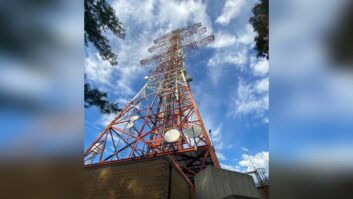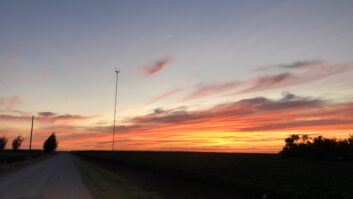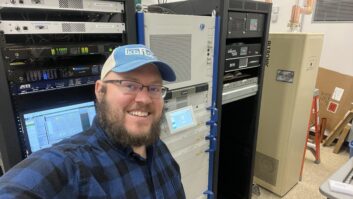
FORT WAYNE, Ind. — Our company had been looking for several years at the opportunity to move our transmitter location to accommodate a power upgrade from 3 kW to 6 kW. After our last tower inspection, we were faced with the fact that our existing tower was nearing its end of life and would need major upgrades or replacement. We decided this was the opportunity to move.
SHOPPING
We secured new real estate and started the process for bids and permits. This would be a completely new site with new hardware and electronics from the ground up, including a 375-foot freestanding tower.
All the major players were contacted for quotes, and after hours of studying proposals and facing the middle-aged reality of reading glasses, I narrowed down my choices and selected ERI for the tower and antenna system.
ERI was not the cheapest tower bid received, but I have worked on many towers, and ERI structures have always seemed to age well. For example: no rusty scratches from thin galvanizing or bent cross members just because some 6-foot, 4-inch 245-pound tower maintenance guy stepped on it. Perhaps what impressed me most were the engineering specs included in the bid. The tower was engineered to exceed my specific needs, and the engineering showed a very comfortable margin of error. Many of the other bids contained some basic information but few showed much math. Several companies threw prepackaged towers at me and said, “This will do the job.”
This is the first tower of any size for which I had direct influence over the purchase, although I had executed numerous projects in which others made the buying decisions. My experience coupled with the reputation of the company led me to select ERI. Additionally, I am blessed to work for a company that believes in doing things right the first time, so choosing long-term value is part of our corporate culture.
The antenna system was nothing tricky, as the pattern is omnidirectional. I selected an ERI four-bay Lynx antenna. It was competitive with others and again, ERI has a solid reputation.
Fast forward a few months, and I received an email from the engineer at the ERI test range presenting me with 14 options for fine tuning. I expected two or three. The attention to detail was impressive. They modeled the tower against the antenna and sent me the outputs, allowing me to fine tune the sweet spots.
We finalized the property purchase, permitting, federal filings, Indian Burial Ground studies, environmental studies, zoning and more federal filings. Finally, in February of 2014, I started ordering equipment. I was a little disappointed that ERI could not start the erection until after July 4 due to project backlogs.
CONSTRUCTION
Did I mention that we bought a landfill?
We purchased a section of an old closed landfill that had been closed and capped for roughly 40 years. Environmental boring revealed a 10-foot clay cap, on top of 10 feet of residential trash, on top of native clay. This meant that the top 20 feet of the foundation piers would be disregarded as having no friction value. Geotech showed the foundation piers needed to be 45 feet deep and 6 feet in diameter, which meant almost 300 tons of concrete would be used for a relatively small tower.
Between February and May we had driveways and fencing installed. The foundation crew arrived early in May. The reinforcement steel was assembled and the drilling began. I was told if they dug up a car or something it might cost extra. We all laughed at that … sort of. The foundation work went reasonably well, and seven days later we had nearly 175 yards of concrete in the ground.
At the beginning of July, the tower crew, contracted by ERI, arrived to receive and unload the tower steel, antenna, feed lines and lighting system from the factory. They did a complete inventory and sorted the parts into lots based on how they planned to assemble the tower. The crew was smaller than I expected, with two or three people on-site the entire time, and up to six when necessary. They assembled the individual 20-foot sections on the ground and laid them out in a big arc, cleverly planned for the swing radius of the crane.
Two weeks of ground work gave way to three days of stacking. The first 140 feet were stacked with a small crane and the remaining height lifted in a single day with the 450-foot crane. I was present for almost the entire stacking process. They stacked the tower sections with all of the bolts tightened on the ground, and I only heard them use a hammer once during the entire stacking process. This was obviously not their first goat rodeo. It took another five days to put up the feed lines, antennas and hardware, and to install the ground system. They were gracious enough to unload our precast building with their cranes, at no additional cost.
The ERI antenna tech arrived near the end of the process to tune the antenna. It took the tech and climbers about 3–4 hours to do a complete sweep and tune the antenna system. ERI emailed me a comprehensive report a few days later. I was pleased the next week when I turned up the new transmitter it showed only 1 W reflected from 3.3 kW output. The VSWR is 1.01 after tuning.
With all of the work completed, the tower crew departed with a plan to return in three days to complete some CAD welds. I took the opportunity to have a third-party inspection done on the tower. It was inspected and photographed from top to bottom, over 300 pictures, and a wrench put to at least 50 percent of the bolts. The report came back with one loose bolt and one missing lock washer, and the climbing pegs were out of sequence in one section. Everything was fixed the next day.
I would give ERI a solid A on the project. The final quote for the project was thorough. The cost overrun was $306, for the rental of a storage container and some generator fuel. ERI did what they said they were going to do, and they did it in a very professional manner.
For information, contact Joe Meleski at ERI in Indiana at (812) 925-6000 or visit www.eriinc.com.












